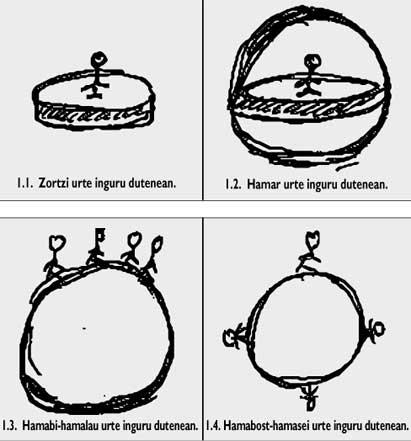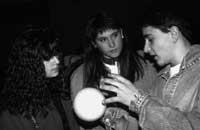Preconception. Universe models

If we ask some children and adolescents to represent themselves on Earth, we can say that we would find four models
If we ask those who are studying in high school, the models would not change much. We are surprised by the parallelism between these ways of understanding and the different historical moments of society.
As a child, when they are about eight years old and have not yet achieved anything outside the family and school sphere, their concepts about the universe are very precise. The earth is flat and located in the center. If they represent a star, the star will revolve around them (the following image would explain a more advanced vision: The sun passes by night under the Earth warming volcanoes). The stars are fixed again and the Moon is maintained by air effect (Figure 1.1).
From what is seen is extracted an expression, sometimes mythical (ghosts, etc.) and other geometric, but always concrete forms and things are the ones that shape perception. They are valid but not generalizable models.
In a second stage, around the age of ten, children no longer draw a plain but spherical world. But they remain within the Earth (see figure 1.2).

More than twelve and thirteen years have the following problem: If the earth is spherical and they are above it, how can they not learn and fall? On the other hand, even if they admit that there are more children, they never accept that they are upside down
When their maturity allows them to make abstractions, they indicate the gravitational field and they know that a force is the cause of no one to fall. This happens around the age of fifteen sixteen (Figure 1.4).
In astronomy classes I used the entire sphere to express the coordinates of the equator and half, above the observer's line, to explain the azimuts. The conclusion that I have drawn working with young people between 14 and 16 years old is that they only understand the horizon, the cardinal points and the representation of the stars that appear on them.
So why have you not expressed all representations with your own ideas? One way to know this is to organize visits. In this way, the student himself will explain what he has seen to the rest of the students. They will only explain what they have understood from memory and the results that are obtained are really exciting.
Students are not empty containers for the pouring of knowledge that the teacher offers them. It seems more than a crusher with different leaves to crush and forgives comparison. This depends on your experience and your mental structure. In this way, each student will introduce the potato offered by the teacher (new knowledge) in a very different way.

The role of the teacher is to discover the prejudices that the student needs to assimilate this new knowledge. Only in this way can you successfully reach the proposed goal.
Above all, it is worth mentioning the knowledge that the different civilizations have had throughout history about the universe:
- Mythical model Representations
of ghosts and gods. They are explanations of periodic phenomena, such as the different seasons of the year, but they are not able to predict new phenomena. - Geocentric, heliocentric
patterns, etc. These, in addition to being able to explain, are also able to predict new situations that have not been seen so far, such as the interplanetary configuration or the Lunar Eclipse. - Cosmogonological models are
the most advanced scientific models. These collect valid scientific laws for the entire universe (unless otherwise proven), such as the law of universal gravitation, the speed of galaxy change or the law of uniformity in the chemical structure of matter.
So, we are able to introduce the topic that interests us. How to teach astronomy? When it comes to teaching, I will distinguish and distinguish three different moments from the development of the personality of the child/youth, without accurately addressing age.





